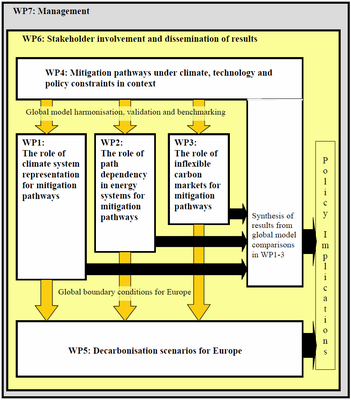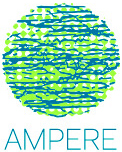Work packages
The working structure AMPERE project included seven work packages (WPs; for a larger version please click on the image). WP 1 to 4 performed a global scale analysis, followed by an in-depth investigation of its implications for the EU27 in WP5. AMPERE was based on strong stakeholder involvment, implelented by WP 6. A separate work package was set up for the project management (WP 7).
 The global scale analysis comprised four work packages (WPs). The WPs 1-3 explored the feasibility and costs of mitigation pathways along three specific dimensions: (1) climate system representations, (2) technology and energy sector limitations in myopic policy settings, and (3) incomplete sectoral and regional coverage of mitigation policies. Each of the WPs contained
The global scale analysis comprised four work packages (WPs). The WPs 1-3 explored the feasibility and costs of mitigation pathways along three specific dimensions: (1) climate system representations, (2) technology and energy sector limitations in myopic policy settings, and (3) incomplete sectoral and regional coverage of mitigation policies. Each of the WPs contained
its own model intercomparison experiment to combine the exploration of the scenario space with an investigation of model uncertainty, its origins and its implications.
WP 4 provided the bracketing of these specific analyses. This included harmonisation of baseline assumptions of participating global models, alignment of experimental designs of the model intercomparisons in WP 1-3, and a synthesis of the results. The latter involved elements of a meta-comparison and second, a broadening of the perspective to the full space of different system and policy assumptions.
Content coordination between WP 1-4 was mainly based on a common set of long-term climate targets expressed in terms of carbon (equivalent) budgets for the 21st century. Enhancing the policy relevance of the analyses was targeted by an assessment of how models as policy evaluation tool relate to the real world policy situation, including a comparison of model benchmarks for measuring policy effects and costs, and validation exercises.
Embedded in the global scale analysis, WP5 conducted an in-depth investigation of the implications for EU27, and resulting strategies for reducing greenhouse gas emissions in the European Union. The linkage between WP 5 and the WPs 1-4 was established by forwarding global boundary conditions for Europe (in terms of, e.g., compatible regional climate targets, energy prices and state of technology). In analogy to the global scale WPs, WP5 also contained a combination of model benchmarking and validation and model intercomparison at the European level.
Not least, the project included a strong stakeholder involvement and dissemination component (WP6) to enhance the dialogue between the integrated assessment modelling community on the one hand and policy makers on the other, and to disseminate the policy implications of the project results.
